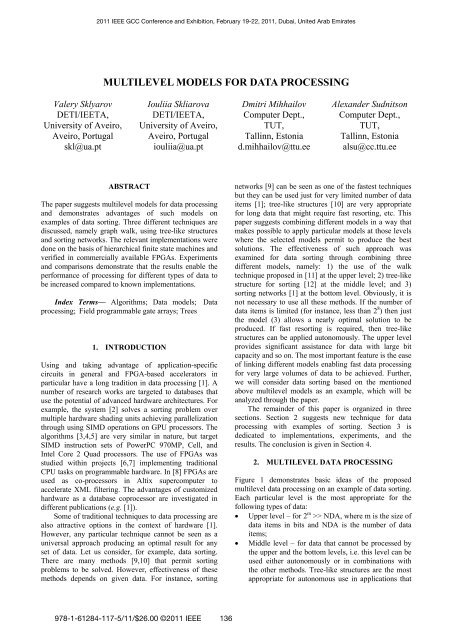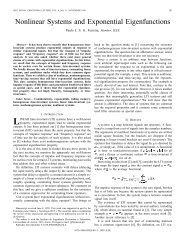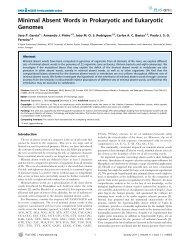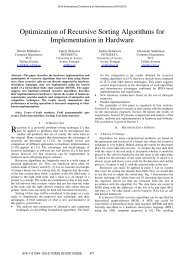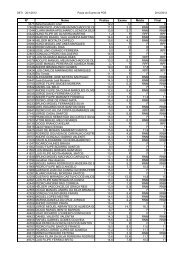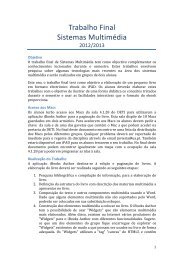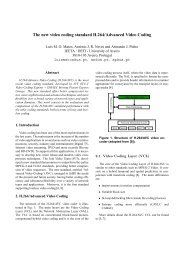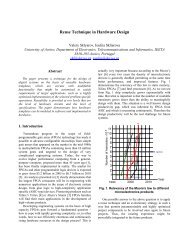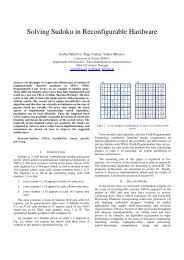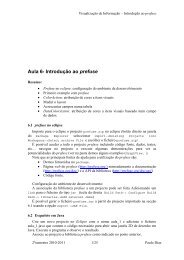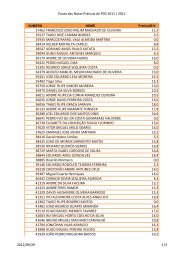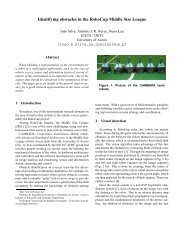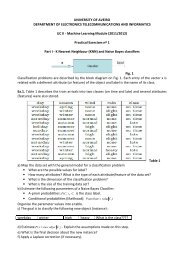Multilevel Models for Data Processing - ResearchGate
Multilevel Models for Data Processing - ResearchGate
Multilevel Models for Data Processing - ResearchGate
Create successful ePaper yourself
Turn your PDF publications into a flip-book with our unique Google optimized e-Paper software.
2011 IEEE GCC Conference and Exhibition, February 19-22, 2011, Dubai, United Arab Emirates<br />
MULTILEVEL MODELS FOR DATA PROCESSING<br />
Valery Sklyarov<br />
DETI/IEETA,<br />
University of Aveiro,<br />
Aveiro, Portugal<br />
skl@ua.pt<br />
Iouliia Skliarova<br />
DETI/IEETA,<br />
University of Aveiro,<br />
Aveiro, Portugal<br />
iouliia@ua.pt<br />
Dmitri Mihhailov<br />
Computer Dept.,<br />
TUT,<br />
Tallinn, Estonia<br />
d.mihhailov@ttu.ee<br />
Alexander Sudnitson<br />
Computer Dept.,<br />
TUT,<br />
Tallinn, Estonia<br />
alsu@cc.ttu.ee<br />
ABSTRACT<br />
The paper suggests multilevel models <strong>for</strong> data processing<br />
and demonstrates advantages of such models on<br />
examples of data sorting. Three different techniques are<br />
discussed, namely graph walk, using tree-like structures<br />
and sorting networks. The relevant implementations were<br />
done on the basis of hierarchical finite state machines and<br />
verified in commercially available FPGAs. Experiments<br />
and comparisons demonstrate that the results enable the<br />
per<strong>for</strong>mance of processing <strong>for</strong> different types of data to<br />
be increased compared to known implementations.<br />
Index Terms— Algorithms; <strong>Data</strong> models; <strong>Data</strong><br />
processing; Field programmable gate arrays; Trees<br />
1. INTRODUCTION<br />
Using and taking advantage of application-specific<br />
circuits in general and FPGA-based accelerators in<br />
particular have a long tradition in data processing [1]. A<br />
number of research works are targeted to databases that<br />
use the potential of advanced hardware architectures. For<br />
example, the system [2] solves a sorting problem over<br />
multiple hardware shading units achieving parallelization<br />
through using SIMD operations on GPU processors. The<br />
algorithms [3,4,5] are very similar in nature, but target<br />
SIMD instruction sets of PowerPC 970MP, Cell, and<br />
Intel Core 2 Quad processors. The use of FPGAs was<br />
studied within projects [6,7] implementing traditional<br />
CPU tasks on programmable hardware. In [8] FPGAs are<br />
used as co-processors in Altix supercomputer to<br />
accelerate XML filtering. The advantages of customized<br />
hardware as a database coprocessor are investigated in<br />
different publications (e.g. [1]).<br />
Some of traditional techniques to data processing are<br />
also attractive options in the context of hardware [1].<br />
However, any particular technique cannot be seen as a<br />
universal approach producing an optimal result <strong>for</strong> any<br />
set of data. Let us consider, <strong>for</strong> example, data sorting.<br />
There are many methods [9,10] that permit sorting<br />
problems to be solved. However, effectiveness of these<br />
methods depends on given data. For instance, sorting<br />
networks [9] can be seen as one of the fastest techniques<br />
but they can be used just <strong>for</strong> very limited number of data<br />
items [1]; tree-like structures [10] are very appropriate<br />
<strong>for</strong> long data that might require fast resorting, etc. This<br />
paper suggests combining different models in a way that<br />
makes possible to apply particular models at those levels<br />
where the selected models permit to produce the best<br />
solutions. The effectiveness of such approach was<br />
examined <strong>for</strong> data sorting through combining three<br />
different models, namely: 1) the use of the walk<br />
technique proposed in [11] at the upper level; 2) tree-like<br />
structure <strong>for</strong> sorting [12] at the middle level; and 3)<br />
sorting networks [1] at the bottom level. Obviously, it is<br />
not necessary to use all these methods. If the number of<br />
data items is limited (<strong>for</strong> instance, less than 2 8 ) then just<br />
the model (3) allows a nearly optimal solution to be<br />
produced. If fast resorting is required, then tree-like<br />
structures can be applied autonomously. The upper level<br />
provides significant assistance <strong>for</strong> data with large bit<br />
capacity and so on. The most important feature is the ease<br />
of linking different models enabling fast data processing<br />
<strong>for</strong> very large volumes of data to be achieved. Further,<br />
we will consider data sorting based on the mentioned<br />
above multilevel models as an example, which will be<br />
analyzed through the paper.<br />
The remainder of this paper is organized in three<br />
sections. Section 2 suggests new technique <strong>for</strong> data<br />
processing with examples of sorting. Section 3 is<br />
dedicated to implementations, experiments, and the<br />
results. The conclusion is given in Section 4.<br />
2. MULTILEVEL DATA PROCESSING<br />
Figure 1 demonstrates basic ideas of the proposed<br />
multilevel data processing on an example of data sorting.<br />
Each particular level is the most appropriate <strong>for</strong> the<br />
following types of data:<br />
• Upper level – <strong>for</strong> 2 m >> NDA, where m is the size of<br />
data items in bits and NDA is the number of data<br />
items;<br />
• Middle level – <strong>for</strong> data that cannot be processed by<br />
the upper and the bottom levels, i.e. this level can be<br />
used either autonomously or in combinations with<br />
the other methods. Tree-like structures are the most<br />
appropriate <strong>for</strong> autonomous use in applications that<br />
978-1-61284-117-5/11/$26.00 ©2011 IEEE 136
equire very fast resorting in case of arriving<br />
additional data items;<br />
• Bottom level – as a rule <strong>for</strong> n ≤ 8 or even smaller,<br />
which depends on available resources, where n is the<br />
selected number of the less significant bits of data<br />
items.<br />
Upper level: search a group where<br />
the new item has to be included or<br />
allocating a new group in memory<br />
Middle level: 1. <strong>Processing</strong> binary<br />
trees associated with each group;<br />
2. Creating new groups associated<br />
with leaves of trees<br />
Bottom level: <strong>Processing</strong> items<br />
associated with the leaves of the<br />
trees by sorting networks<br />
Figure 1. <strong>Multilevel</strong> data processing on an example of data<br />
sorting<br />
2.1. Tree walk technique<br />
Suppose we need to sort m-bit data items. Let us<br />
decompose m-bit binary values in 2 N groups that differ<br />
by the N most significant bits. Let us assume that data<br />
items within each group will be sorted by applying some<br />
methods, which we will discuss a bit later. At the upper<br />
level we have to find a proper group <strong>for</strong> any new<br />
incoming data item. In practical cases <strong>for</strong> data with large<br />
bit capacity (<strong>for</strong> instance, more than 64) the number of<br />
groups is significantly less than 2 N . Thus, we can apply<br />
the technique [11] proposed <strong>for</strong> accelerating Boolean<br />
constraint propagation needed <strong>for</strong> solving the SAT<br />
problem with large number of variables and limited<br />
number of clauses.<br />
Figure 2 demonstrates an example, taken from [11],<br />
in which we consider groups instead of clauses. Similar<br />
to [11] the group index walk module uses a tree to<br />
efficiently locate the group associated with any new<br />
incoming data item. The tree will be N/k deep and it is<br />
stored in the tree walk table in an on-chip BRAM block.<br />
Here we consider 2 k -nary trees and N/k is the number of<br />
assigned levels of the tree, through which the walk<br />
procedure from the root of the tree to a leaf (associated<br />
with a particular group) will be done. If k=1 we have a<br />
binary tree. The greater the number k the less number of<br />
levels of the tree we need <strong>for</strong> our walk procedure. Given<br />
a non-leaf node, the address of its leftmost child in the<br />
tree walk table is called the base index of this tree node.<br />
The rest of the children are ordered sequentially,<br />
following the leftmost child. There<strong>for</strong>e, to locate the i th<br />
child, the index can be calculated by adding i to the base<br />
index. If a child is not associated with any group, we<br />
store a no-match (-1) tag in the entry. If <strong>for</strong> a node, all of<br />
its 2 k children have no match, then we do not expand the<br />
tree node and just store a no-match tag in the node itself.<br />
The considered technique is almost the same as in [11].<br />
Root base<br />
index 0000 1 st memory lookup<br />
00 01 10 11<br />
0000 Base<br />
0 1 0001 No 2 0010 No 3<br />
index 0100 match<br />
match<br />
00 01<br />
10<br />
00 01<br />
11<br />
0011 Base<br />
index 1000<br />
0100 No 0101 0110 No 0111 No 1000 1001 No 1010<br />
4 5 6 7 8 9 10 11<br />
match Group 1 match match Group 12 match Group 14<br />
Group 13<br />
10<br />
2 nd memory<br />
lookup<br />
11<br />
1011 No<br />
match<br />
Figure 2. Group index tree work [11] trans<strong>for</strong>med to data sort<br />
Let us consider example from [11] shown in Figure 2<br />
and trans<strong>for</strong>m it to the new problem (i.e. sorting will be<br />
considered instead of the SAT). Suppose k=2, N=4 and<br />
some data items have already been included in the groups<br />
1, 12 and 14. Let the most significant bits of a new data<br />
item be 1101. The base index of the root node is 0000<br />
and the first two bits of the data are 11. The table index is<br />
the sum of two: 0000+11= 0011. Using this table index,<br />
the first memory lookup is conducted by checking the<br />
0011 entry of the table. This entry shows that the next<br />
lookup is an internal tree node with the base index 1000.<br />
Following this base index, adding it to the next two bits<br />
of the input 01, we reach the leaf node 1000+01 = 1001.<br />
This leaf node corresponds to the group in which the item<br />
1101 has to be added. Thus, the no match index will be<br />
replaced with the new group, i.e. group 13 10 = 1101 2 .<br />
New group is indicated by the address of the root of the<br />
relevant tree in memory. Now m-N most significant bits<br />
of data <strong>for</strong> groups (such as the group 13 <strong>for</strong> our example)<br />
will be sorted using tree-like structures.<br />
2.2. Tree-like structures<br />
Tree-like data structures are frequently explored <strong>for</strong> data<br />
processing [10,13]. Let us consider an example of using a<br />
binary tree <strong>for</strong> sorting data [13]. Suppose that the nodes<br />
of the tree contain three fields: a pointer to the left child<br />
node, a pointer to the right child node, and a value (e.g.<br />
an integer or a pointer to a string). The nodes are<br />
maintained so that at any node, the left sub-tree only<br />
contains values that are less than the value at the node,<br />
and the right sub-tree contains only values that are<br />
greater. Such a tree can easily be built and traversed<br />
either iteratively or recursively. Taking into account the<br />
experiments in [14,15] we can conclude that hardware<br />
implementations of recursive and iterative algorithms<br />
over trees give very comparable results in resource<br />
consumption and execution time. We will base our<br />
technique on recursive algorithms just because they<br />
provide more clear and compact specification. The results<br />
of the paper are equally applied to both recursive and<br />
iterative implementations.<br />
Two (following each other) algorithms A 1 and A 2<br />
have to be executed <strong>for</strong> data sort in [13]. The first one A 1<br />
constructs the tree. The second algorithm A 2 outputs the<br />
sorted data from the tree. A 1 executes the following steps:<br />
1) compare the new data item with the value of the root<br />
node to determine whether it should be placed in the subtree<br />
headed by the left node or the right node; 2) check<br />
137
<strong>for</strong> the presence of the node selected by 1) and if it is<br />
absent, create and insert a new node <strong>for</strong> the data item and<br />
end the process; 3) otherwise, repeat 1) and 2) with the<br />
selected node as the root. Recursion can easily be applied<br />
in point 3 [15]. Let us assume that a sequence of input<br />
data is the following: 24, 17, 35, 30, 8, 61, 12, 18, 1, 25,<br />
10, 15, 19, 20, 21, 40, 9, 7, 11, 16, 50. A tree built <strong>for</strong><br />
this sequence is shown in Figure 3a. Basic steps of A 2 are<br />
shown in Fig. 3b. We will assume that input data are<br />
stored in RAM along with the addresses of the left (LA)<br />
and right (RA) sub-trees (see Figure 3c). All other details<br />
can be found in [14,15].<br />
7<br />
a)<br />
1<br />
9<br />
8<br />
10<br />
17<br />
18<br />
12<br />
11<br />
15<br />
25<br />
24<br />
30<br />
19<br />
16<br />
35<br />
40<br />
61<br />
20<br />
50<br />
21<br />
b)<br />
no<br />
z<br />
Begin<br />
Left sub‐tree<br />
exists<br />
yes<br />
Call Z again <strong>for</strong><br />
left node as a root<br />
Output data from<br />
the last node<br />
c)<br />
RAM<br />
<strong>Data</strong> LA RA<br />
Right sub‐tree<br />
exists<br />
yes<br />
Call Z again <strong>for</strong><br />
right node as a root<br />
Figure 3. Binary tree <strong>for</strong> data sort (a); recursive algorithm <strong>for</strong><br />
data sort (b); contents of memory (c)<br />
2.3. Sorting networks<br />
Sorting networks [1] do not require control flow of<br />
instructions or branches and they are parallel in nature.<br />
However, they are only suitable <strong>for</strong> relatively short<br />
sequences of data whose length is known a priori [1].<br />
This paper suggests combining tree-like structures<br />
(see the middle level in Figure 1) with sorting networks<br />
(see the bottom level in Figure 1).<br />
Suppose we need to sort m-bit data items. Let us sort<br />
(m-n) the most significant bits at upper two levels (see<br />
Figure 1) and process the remaining n bits using sorting<br />
networks. Let us consider an example shown in Figure 4<br />
<strong>for</strong> m=4, n=2 and the following sequence of inputs:<br />
3(0011), 8(1000), 1(0001), 6(0110), 9(1001), 13(1101),<br />
15(1111), 7(0111), 11(1011), 10(1010), 14(1110), where<br />
the binary code of the relevant decimal value is shown in<br />
parenthesis.<br />
a)<br />
b)<br />
the root 00 3,1<br />
10<br />
0,1,3,2<br />
2,3 01 11 1,3,2<br />
2<br />
3<br />
2<br />
3<br />
End<br />
1<br />
3 0<br />
1<br />
2<br />
3<br />
1<br />
3<br />
2<br />
Group 00 (0): 0001(1),0011(3);<br />
Group 01 (1): 0110(6),0111(7),<br />
Group 10 (2): 1000(8),1001(9),1010(10),1011(11),<br />
Group 11 (3): 1101(13),1110(14),1111(15)<br />
Figure 4. Combining tree-like structure and sorting networks<br />
For this example m-n=2 the most significant bits<br />
arrive in the following sequence: 00, 10, 01, 11. The<br />
relevant bits are shown in italic in Figure 4 and in the<br />
text. The tree <strong>for</strong> this sequence is shown in Figure 4a.<br />
1<br />
2<br />
3<br />
no<br />
There are two less significant (n=2)-bit values associated<br />
with the group 00 namely 11 (3) and 01 (1). The values 3<br />
and 1 are written near the node 00 in Figure 4a. By<br />
analogy (n=2)-bit values associated with each group are<br />
shown near the other nodes 10, 01 and 11 in Figure 4a.<br />
All associated values are ordered in ascending sequence<br />
using sorting networks (see Figure 4a where networks<br />
from [1] were used). Thus, the groups are sorted using<br />
tree-like structures and the values associated with the<br />
groups are sorted using networks. Comparators needed<br />
<strong>for</strong> the networks are represented in Figure 4a through the<br />
known Knuth notation [9]. The results of sorting are<br />
shown in Figure 4b.<br />
Note that it is not necessary to store the associated<br />
with the nodes values explicitly. They can be indicated<br />
by values '1' of bits in the respective binary word. Such<br />
words <strong>for</strong> the nodes 00, 10, 01 and 11 in Figure 4a are<br />
0101, 1111, 0011 and 0111.<br />
3. IMPLEMENTATIONS AND EXPERIMENTS<br />
The considered methods were implemented and tested in<br />
FPGA. <strong>Processing</strong> of trees at upper and middle levels<br />
was done with the aid of a hierarchical finite state<br />
machine (HFSM) [16] using the methods [15].<br />
Specifications <strong>for</strong> the algorithms (e.g. Figure 3b) can be<br />
seen as flow-charts with some predefined constraints.<br />
Such flow-charts can easily be converted to a HFSM<br />
(using the method [16]) and then <strong>for</strong>mally coded in a<br />
hardware description language such as VHDL. The<br />
coding is done using the template proposed in [14],<br />
which is easily customizable <strong>for</strong> the given set of flowcharts.<br />
The resulting (customized) VHDL code is<br />
synthesizable and permits the relevant circuits to be<br />
designed in commercially available CAD systems, such<br />
as Xilinx ISE (all necessary details can be found in [14-<br />
16]).<br />
The synthesis and implementation of the circuits from<br />
the specification in VHDL were done in Xilinx ISE 11<br />
<strong>for</strong> FPGA Spartan3E-1200E-FG320 of Xilinx available<br />
on NEXYS-2 prototyping board of Digilent Inc. Since<br />
the experiments were per<strong>for</strong>med in a cheap FPGA that<br />
has limited resources the methods used at each level were<br />
verified separately. Preliminary results <strong>for</strong> the upper level<br />
are very similar to [11] because the method [11] was used<br />
with minimal modifications. For the middle level a<br />
random-number generator produced up to 2 12 data items<br />
with a length of 14 bits that are supplied in portions to<br />
the circuits that have to sort the previously received<br />
portions of data and to resort them <strong>for</strong> a new portion as<br />
soon as possible. Besides, the both types were evaluated<br />
without and with sorting networks <strong>for</strong> different values of<br />
n.<br />
Fig. 5 permits to compare acceleration of resorting <strong>for</strong><br />
a new portion (that includes from 10 to 120 data items)<br />
comparing with resorting all 2 12 data items in FPGAbased<br />
circuits.<br />
The algorithm shown in Fig. 3b was also described in<br />
C++ and implemented in software. The same data<br />
138
(randomly generated) were used <strong>for</strong> the software<br />
implementations. The results were produced on HP<br />
EliteBook 2730p (Intel Core 2 Duo CPU, 1.87 GHz)<br />
computer. They show that hardware implementations are<br />
faster than software implementations <strong>for</strong> all the<br />
experiments even though the clock frequencies of the<br />
FPGA and the PC differ significantly. Indeed, the clock<br />
frequency of the PC is about 25 times faster than that of<br />
the FPGA. However, in spite of a significantly lower<br />
clock frequency, the per<strong>for</strong>mance of sorting operations in<br />
FPGA is about 4.5 times faster than in software<br />
implementations. This is because the optimization<br />
technique [12,16] valid just <strong>for</strong> hardware circuits has<br />
been applied.<br />
acceleration comparing with<br />
full resorting of 2 12 data items<br />
500<br />
450<br />
400<br />
350<br />
300<br />
250<br />
200<br />
150<br />
100<br />
50<br />
10<br />
20<br />
30<br />
40<br />
50<br />
60<br />
70<br />
80<br />
90<br />
100<br />
110<br />
120<br />
number of data items in each portion<br />
Figure 5. The results of experiments<br />
When we combined tree-like structures and sorting<br />
networks we were able to provide acceleration of sorting<br />
in an average 1.6/3.1/4.7 times <strong>for</strong> different values of n:<br />
n=2/n=3/n=4 respectively. Regardless of parallelization<br />
of 2 n operations, acceleration cannot be equal to 2 n<br />
because the use of sorting networks gives significant<br />
delay in getting the results due to long paths in the<br />
relevant combinational circuits.<br />
Now let us make a comparison with other known<br />
results. In [1] the complete median operator to process<br />
256 MB of data consisting of 4-byte words takes 6.173<br />
seconds, i.e. 100 ns per word. Any resorting <strong>for</strong> a new<br />
portion of data requires all data items to be sorted and,<br />
thus, <strong>for</strong> data from Figure 5, it takes about 4<br />
milliseconds. For our technique and <strong>for</strong> examples in<br />
Figure 5, it takes from 130 to 1100 nanoseconds <strong>for</strong><br />
different number of items in portions.<br />
In [17] the maximum speed of sorting is estimated as<br />
180 million records per second. Thus, resorting all data in<br />
Figure 5 would require about 23 milliseconds.<br />
4. CONCLUSION<br />
The paper suggests multilevel models <strong>for</strong> data<br />
processing and clearly demonstrates the advantages of<br />
the innovations proposed based on prototyping in FPGA<br />
and experiments with the implemented algorithms. The<br />
technique is illustrated by examples of data sorting where<br />
three different models (graph walk, tree-like structures<br />
and sorting networks) are combined.<br />
5. REFERENCES<br />
[1] R. Mueller, J. Teubner, G. Alonso, “<strong>Data</strong> processing on<br />
FPGAs”, Proc. VLDB Endowment 2(1), 2009.<br />
[2] N.K. Govindaraju, J. Gray, R. Kumar, D. Manocha,<br />
“GPUTeraSort: High per<strong>for</strong>mance graphics co-processor sorting<br />
<strong>for</strong> large database management”, Proc. 2006 ACM SIGMOD<br />
Int'l Conference on Management of <strong>Data</strong>, Chicago, IL, USA,<br />
pp. 325-336, 2006.<br />
[3] H. Inoue, T. Moriyama, H. Komatsu, T. Nakatani, “AA-<br />
Sort: A new parallel sorting algorithm <strong>for</strong> multi-core SIMD<br />
processors”, Proc. Int'l Conference on Parallel Architecture and<br />
Compilation Techniques (PACT), Brasov, Romania, pp. 189-<br />
198, 2007.<br />
[4] B. Gedik, R.R. Bordawekar, P.S. Yu, “CellSort: High<br />
per<strong>for</strong>mance sorting on the Cell processor”, Proc. 33rd Int'l<br />
Conference on Very Large <strong>Data</strong> Bases (VLDB), Vienna,<br />
Austria, pp. 1286-1297, 2007.<br />
[5] J. Chhugani, A.D. Nguyen, V.W. Lee, W. Macy, M. Hagog,<br />
Y.K. Chen, A. Baransi, S. Kumar, P. Dubey, ”Efficient<br />
implementation of sorting on multi-core SIMD CPU<br />
architecture”, Proc VLDB Endowment 1(2), pp. 1313-1324,<br />
2008.<br />
[6] D.J. Greaves, S. Singh, “Kiwi: Synthesis of FPGA circuits<br />
from parallel programs”, Proc. IEEE Symposium on Field-<br />
Programmable Custom Computing Machines (FCCM), 2008.<br />
[7] S.S. Huang, A. Hormati, D.F. Bacon, R. Rabbah, “Liquid<br />
Metal: Object-oriented programming across the<br />
hardware/software boundary”, European Conference on Object-<br />
Oriented Programming, Paphos, Cyprus, 2008.<br />
[8] A. Mitra, M.R. Vieira, P. Bakalov, V.J. Tsotras, W. Najjar,<br />
“Boosting XML Filtering through a scalable FPGA-based<br />
architecture”, Proc. Conference on Innovative <strong>Data</strong> Systems<br />
Research (CIDR), Asilomar, CA, USA, 2009.<br />
[9] D.E. Knuth, The Art of Computer Programming, Volume 3:<br />
Sorting and Searching, 2nd edn., Addison-Wesley, 1998.<br />
[10] T.H. Cormen, C.E. Leiserson, R.L. Rivest, C. Stain,<br />
Introduction to Algorithms, 2nd edition, MIT Press, 2002.<br />
[11] J.D. Davis, Z. Tan, F. Yu, L. Zhang, “A practical<br />
reconfigurable hardware accelerator <strong>for</strong> Boolean satisfiability<br />
solvers”, Proc. of the 45th ACM/IEEE Design Automation<br />
Conference - DAC 2008, pp. 780 – 785.<br />
[12] V. Sklyarov, I. Skliarova, "Recursive and Iterative<br />
Algorithms <strong>for</strong> N-ary Search Problems", Proc. of AISPP'2006,<br />
19th IFIP World Computer Congress - WCC'2006, Santiago de<br />
Chile, Chile, August 2006, pp. 81-90.<br />
[13] B.W. Kernighan, D.M. Ritchie, The C Programming<br />
Language, Prentice Hall, 1988.<br />
[14] V. Sklyarov, “FPGA-based implementation of recursive<br />
algorithms,” Microprocessors and Microsystems. Special Issue<br />
on FPGAs: Applications and Designs, vol. 28/5-6, pp. 197–211,<br />
2004.<br />
[15] D.Mihhailov, V.Sklyarov, I.Skliarova, A.Sudnitson.<br />
“Hardware Implementation of Recursive Algorithms”. In Proc.<br />
of the 53rd IEEE Int. Symposium on Circuits and Systems,<br />
Seattle, USA, August, 2010.<br />
[16] Sklyarov, V, Hierarchical Finite-State Machines and Their<br />
Use <strong>for</strong> Digital Control, IEEE Transactions on VLSI Systems,<br />
1999, Vol. 7, No 2, pp. 222-228.<br />
[17] R.D. Chamberlain, N. Ganesan, “Sorting on<br />
Architecturally Diverse Computer Systems”, Proc. 3rd Int’l<br />
Workshop on High-Per<strong>for</strong>mance Reconfigurable Computing<br />
Technology and Applications, November 2009.<br />
139


